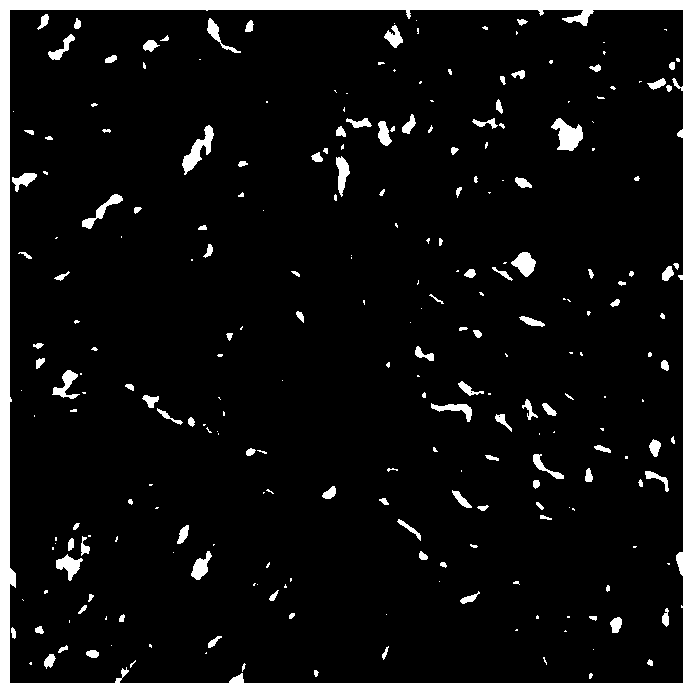Classified display and quantitative detection method for martensite and retained austenite in m‑a islands
A quantitative detection method, technology of retained austenite, applied in the field of iron and steel materials, can solve problems such as difficult to distinguish austenite, neglect of important details, difficult to quantitative statistics, etc., to avoid cumbersome sample preparation, good economy and society Benefits, effects with a wide range of applications
- Summary
- Abstract
- Description
- Claims
- Application Information
AI Technical Summary
Problems solved by technology
Method used
Image
Examples
Embodiment 1
[0050] 1. Sample preparation
[0051] (a) In this example, 2.25Cr-1Mo-0.25V steel is used to prepare metallographic samples in the normalized state. The samples are generally 10×10×10mm or 8×8×8mm cubes or of cylinders. There are no specific requirements for sample size, but the sample should be chosen to be representative.
[0052] (b) The ground sample is roughly ground on a metallographic sample grinding machine, and finely ground on an automatic sample grinding machine with 150#, 400#, 800#, 1200#, and 2000# metallographic sandpaper, and the naked eye does not see If there are obvious scratches, prepare for subsequent mechanical polishing.
[0053] (c) Mechanical polishing. The polishing speed is preferably 250~350r / min, and the polishing paste is diamond polishing paste with a particle size of W2.5 (1.5μm~2.5μm). After polishing, the surface of the sample is smooth and flawless, and there are no small scratches under the microscope .
[0054] (d) Electropolishing. ...
Embodiment 2
[0068] The material used in this example is G18CrMo2-6 steel. After normalizing + sand cooling, the microstructure of the sample is mainly composed of granular bainite and a small amount of acicular ferrite. The sample preparation process of this example is the same as the method of Example 1, but because the corrosion resistance of the material in this example is poor, 2wt% nitric acid alcohol solution is used for corrosion time of 5-10s during pre-corrosion, and the constant temperature oxidation temperature is adjusted to 160 ~180℃, holding time is 4~6 hours.
[0069] Figure 5 It is the metallographic diagram of the material of this embodiment after ordinary corrosion, Figure 6 Be the metallographic diagram of present embodiment material after LePera reagent corrodes, Figure 7 The metallographic diagram of the material in this example after using the etching method of the present invention.
[0070] It can be seen from the above three figures that ordinary corrosion c...
Embodiment 3
[0072] The material used in this example is SA508-3 steel, and the microstructure of the sample is mainly composed of granular bainite after normalizing + air cooling treatment. The sample preparation process of this example is the same as the method of Example 1. During the pre-etching, 5wt% nitric acid alcohol solution is used for etching for 5-8s, the constant temperature oxidation film forming temperature is adjusted to 240-280°C, and the holding time is 2-4 hours.
[0073] Figure 8 It is the metallographic diagram of the material of this embodiment after ordinary corrosion, Figure 9 Be the metallographic diagram of present embodiment material after LePera reagent corrodes, Figure 10 The metallographic diagram of the material in this example after using the etching method of the present invention.
[0074] It can be seen from the above three figures that ordinary corrosion can only partially distinguish the microstructural features of the material of this example, and...
PUM
 Login to View More
Login to View More Abstract
Description
Claims
Application Information
 Login to View More
Login to View More - R&D
- Intellectual Property
- Life Sciences
- Materials
- Tech Scout
- Unparalleled Data Quality
- Higher Quality Content
- 60% Fewer Hallucinations
Browse by: Latest US Patents, China's latest patents, Technical Efficacy Thesaurus, Application Domain, Technology Topic, Popular Technical Reports.
© 2025 PatSnap. All rights reserved.Legal|Privacy policy|Modern Slavery Act Transparency Statement|Sitemap|About US| Contact US: help@patsnap.com



